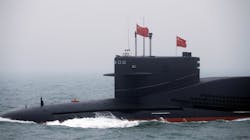Chinese submarine-launched torpedoes getting more sophisticated, and may approach best U.S. ASW torpedoes
BEIJING – The current fleet of Chinese submarine-launched torpedoes represents an interesting blend of Soviet, American and commercial off-the-shelf (COTS) technology. The National Interest reports. Continue reading original article
The Military & Aerospace Electronics take:
15 Jan. 2020 -- From the Yu-4, a domestic completion of an incomplete Soviet design, to the Yu-6, which uses an Intel microprocessor to power its guidance components, the torpedoes of the People’s Liberation Army Navy (PLAN) show significant traces of reverse engineering.
But how capable are they? Do they really improve on the designs on which they are based, and effectively integrate COTS technology, or stand up to the designs from which they were reverse engineered?
The capture of an American MK 46 mod 1 torpedo by a Chinese fisherman in the South China Sea in 1978 was a game changer for Chinese torpedo design. Chinese engineers quickly adopted the MK 46’s Otto Fuel II technology to make their own torpedo-propulsion units more compact and powerful.
Related: China developing lidar-based satellite to detect deep-diving submarines
John Keller, chief editor
Military & Aerospace Electronics
